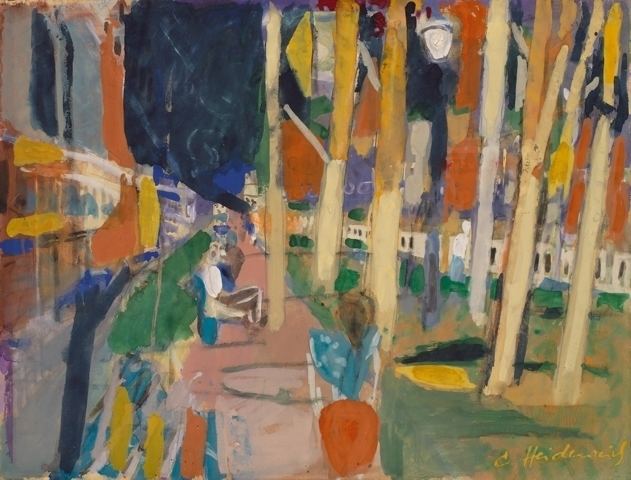Nationality German-American Died September 6, 1965 Role Artist | Name Carl Heidenreich Known for Painting | |
 | ||
Born 4 October 1901 ( 1901-10-04 ) Bad Berneck, Germany | ||
Carl Heidenreich (1901-1965) was a German American artist and an important contributor to Abstract Expressionist movement in New York.
Contents
Life in Germany
Heidenreich was born on October 4, 1901 in Bad Berneck and studied art in the National Arts School in Munich, later becoming a student of Hans Hofmann at his private art school, considered the most progressive in Germany. In 1922, Heidenreich moved to Berlin, where he supported himself as a scene painter in the UFA studios in Babelsberg. Since the mid-1920s, Heidenreich exhibited actively, including exhibitions at Berlin Secession and Berlin Academy of Arts. His work was strongly rooted in German Expressionism, as evidenced by such paintings as Street Encounter (1932).
Politics
Heidenreich was a member of the Communist Party of Germany (KPD). After the Nazi rise to power in 1933, Heidenreich was deemed a degenerate artist and his upcoming solo exhibition in Munich was abruptly cancelled. He was imprisoned by the SS at Berlin's Moabit prison, used as the detention center by the Gestapo. After his release in 1934, Heidenreich escaped to France, leaving behind nearly 300 works, most of them destroyed and lost. During the Spanish Civil War, Heidenreich joined the International Brigades of POUM, an anti-Stalinist Spanish Communist Party, to fight against Franco and fascism. In 1938, he was incarcerated and tortured in Barcelona's Modelo prison. A number of paintings and works on paper, documenting this period of Heidenreich's life, survived in private collections. Among them are a series of prison sketches.
After the end of the Spanish Civil War, Heidenreich returned to Paris, where he stayed until the outbreak of World War II. In 1941 he fled to the United States via Marseille, Casablanca, and Martinique. An important group of watercolors records his impressions of the peaceful Caribbean island.
Art Career in the US
Heidenreich settled in New York, where he was welcomed by the community of German and German Jewish refugee intellectuals, including Hannah Arendt and her husband Henrich Blucher. In 1949, Heidenreich became an American citizen and had a first major exhibition at Harry Salpeter Gallery. Throughout the 1950s and early 1960s, Heidenreich exhibited regularly, his work was widely collected, and he made significant contributions to Abstract Expressionism, both as a painter and watercolorist. His works were included in the collections of Whitney Museum of American Art, Smithsonian American Art Museum, and Brooklyn Museum. In 1965, Heidenreich returned to Germany for the first time in 30 years to attend his exhibitions in Frankfurt and Berlin. Already suffering from a serious illness, he died in Frankfurt on September 6, 1965.
A significant number of art works left behind in Heidenreich's New York studio have been cared for by family friends and collectors, primarily Richard M. Buxbaum and Emanuel Wolf, who have maintained the artist's legacy through continued exhibitions and publications. In 2004, Heidenreich’s work was shown along with his teacher’s (Hans Hofmann) at a major exhibition at the Berkeley Art Museum/Pacific Film Archive. In the same year, Goethe Institut in New York presented a retrospective of Heidenreich’s American work and published a catalog with essays by Peter Selz, Alla Efimova, and Gabriele Saure.
